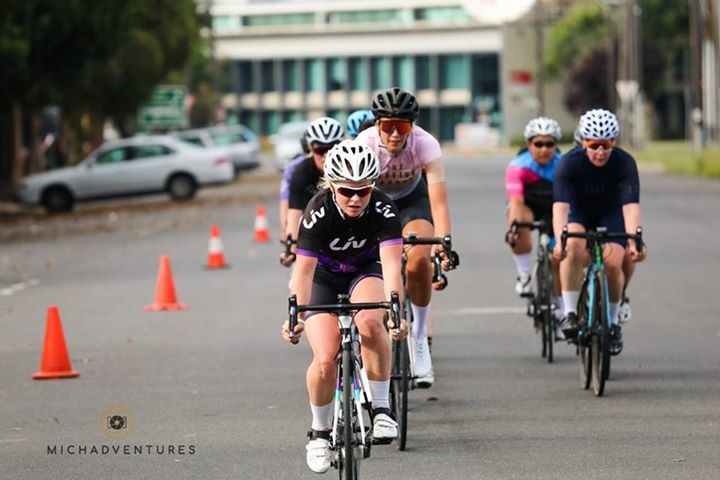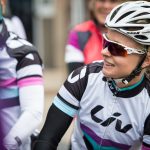When heading into winter or the offseason, most triathletes will sit down and review the running calendar to see which run races they will incorporate as part of their training. But how many triathletes sit down and mull over the cycling calendar to decide which bike races they will enter? Surprisingly, or not, only a small minority.
I’m not talking about your mass group/participation rides; I’m talking about actually ‘bike racing’ – where you pin on a number, line up against pure cyclists and race for placings.
This got me thinking, and I wondered why only a small number of triathletes participate in bike racing. When I delved a little deeper, I learnt that unless a triathlete comes from a cycling background, they don’t really know a great deal about the cycling community. Triathletes may feel intimidated or don’t even know where to start, so they simply don’t even bother considering it. The thought of crashing also puts many triathletes off and can be one of the reasons many triathletes are too nervous to give bike racing a go. Along with this, many triathlon coaches aren’t involved in the cycling community either, so they don’t discuss the option of including bike racing into a triathletes training program, as they too don’t know enough about the sport to add it.
If you are looking at focusing on the bike leg over winter, I’ll show you why and how to incorporate bike racing into your training mix to help you become a stronger and more skilled cyclist, so you can transform into a stronger all round triathlete.

WHY you should incorporate bike racing into your training:
1. Build your bike skills
In swimming, we practice and incorporate tumble turns into training even though we don’t need the specific skill in racing, but we know the benefits it offers. In cycling, developing, practising and incorporating bike skills is exactly the same. Traditionally triathletes are not known for their bike handling and skills. This is mainly because triathletes don’t see the need to learn these skills as we don’t use them in racing. However, the skills you develop in bike racing, just like the skills developed in open water swim events, help you to develop the necessary skills to become a better cyclist and bike handler overall. This is not only beneficial to you becoming faster but also helps for safety reasons too. Plus, the more skilled you are on the bike, the more confident you will be and the more you will be able to push yourself – whether when riding by yourself or in a faster group.
2. Race specific skills (draft legal)
Bike racing helps you develop key race specific bike skills, including drafting, bike handling, strategic racing skills and more, and the winter season is the perfect time to hone these skills against other top cyclists. It’s hard to simulate this type of racing and skills in training, so bike races, and in particular criterium racing, are the perfect way to improve these skills.
3. Provides winter motivation
If you are a fair weather rider or sometimes struggle for motivation with getting on the bike in the dark/cold winter months, then entering some bike racing events is an excellent way to get out and get your long ride done, and keep the motivation high. Just the same as entering running events over winter, bike racing allows you to stay focused, and have something to work towards during the times when triathlon races seem so far away.
4. Train and race with those stronger than you
To become better at something, you should train with those who are better than you. Most triathletes will consider themselves decent runners until they enter run events and run against pure runners. The same goes for cycling. Enter into a bike race or two, and you will soon learn that even the strongest triathlete riders will find it hard to compare to the strongest cyclists. This is a great way to challenge and push yourself against some of the strongest in their field and drive yourself to become stronger yourself.
5. Changing your training stimulus
If you have been training and racing for a few years, you will probably find you go through a similar winter season year after year. Long aerobic and hilly rides, building up the duration or the elevation over the months, but essentially the same (or very similar) training stimulus each year is rolled out. There’s a great saying: “If you always do what you’ve always done, you will always get what you’ve always got.” Bike racing incorporates a great mix of different training stimulus on the body’s energy systems – aerobic (sitting in the bunch), threshold (chasing a pack), VO2 (holding off a chase) strength (hills), power (sprinting to the finish). And just like any other event/race, it’s hard to simulate these top efforts in training, and so racing can give you that extra five to 10 percent you may be looking for. Changing up your training and including a different stimulus such as bike racing can provide you with the stimulus your training may just be looking for.
6. It’s safer than you think
Yes, there are crashes in races, and you may see them happen, but it doesn’t mean you will be involved in one. I’ve raced for three years and haven’t had one crash. In general, crashes happen because an athlete takes too big of a risk (and it doesn’t come off), or because an athlete stops concentrating or isn’t aware of the other athletes. This can all happen in training too. If you’re scared of crashing, my advice is to race to your ability, know your limits, and develop the skills and confidence over time. And again, just like in swimming, position yourself in a pack where you feel comfortable. In bike racing, if you are not confident, the worst place you can sit is in the middle of the pack. So, start off by learning from the peloton on the back or side of the pack, and get a feel for the other riders and gain your confidence. Then make your way into the pack, taking turns and making moves. For my first few races, all I did was sit on the back, watch and learn. This was the best thing I could ever do to learn and stay safe!
7. Keeping it fun
If you feel like you have started to lose your mojo on the bike, or training in general, changing things up can be a breath of fresh air. Having a new and different focus over winter can help to bring back your motivation and throwing in some bike racing may just be the catalyst you need!

HOW to include bike racing into your training:
Have I convinced you yet, to give bike racing a go this winter? Awesome! Here are some key things to get you started:
1. Equipment: You will need a road bike – tri bikes are illegal in road races.
2. Watch and learn: Head down to a local race to first watch a race in action. Watch how the experienced riders navigate the peloton, the lines they take, how they spend their time and energy in a pack, and how they set themselves up for attacks or the finish line sprint. Watching and learning can be one of the best ways to learn from the best.
3. Join a cycling Club: The cycling culture and club support are fantastic, so I suggest simply finding a club close to you and enquiring with them. A list of clubs is available from your state cycling body (i.e., Cycling Victoria). Clubs are fantastic at supporting those new to the sport and can provide you with plenty of guidance and information on getting started. Note: most Clubs will have a small annual fee to join.
4. Have the basic skills: Even though you will use racing to develop your bike skills, it is still important that you are competent and comfortable on local group/training rides first. Basic bike skills that you will need include not only having base fitness/endurance but also base bike handling skills, knowledge of pack etiquette, knowing how to draft and corner, and having rider/situational awareness – these are all essential to riding safely. In bike racing (and pack riding in general) you want smooth movements rather than sudden changes. You also want to hold a constant line through corners. If you are unsure whether your skills are up to scratch, most local cycling clubs offer bike skills courses and trials before entering a race.
5. Get your insurance: Just like Triathlon Australia, Cycling Australia requires you to hold a license for insurance purposes to race. A great way to ‘try before you buy’ is purchasing a three-race license so you can try out a few races before signing up to an annual Cycling Australia Membership.
6. Choose your event/s: There are a number of different types of bike racing including road races, criteriums, time trials and two to three-day tours, all of which are an excellent way to improve your skills, strength and performance on the bike. A time trial is an easy one to start with, and you may want to gravitate towards this, but really they are more like a triathlon than a bike race. Criteriums only happen over the summer season, so in winter, road races are a great place to start. Start by choosing road races on courses that are less technical until you build up your confidence. Find out what races are on in your area/state by contacting the state cycling body (Cycling Australia).
7. Find your grade: Most races are graded A, B, C, D, etc., with grade A being the strongest, and cyclists are graded accordingly, based on previous races. If this is going to be your first bike race start in a lower grade and ease yourself into racing – you can always move up once you gain your confidence. There is nothing worse than entering a grade above your ability and getting dropped by the bunch in the first five minutes and finding yourself riding by yourself for the rest of the race.
8. Give it a go: Once you have done your research, it’s simply about biting the bullet, entering and giving it a go!
As you sit down over winter and plan your season, throw up the idea of incorporating bike racing into your training mix. Then watch as your bike strength and endurance improves along with your enjoyment!
Written by Coach Sarah, as previously published in Australian Triathlete Magazine
~ ~ ~~ ~ ~ ~~ ~ ~ ~
Sarah is the Director & Head Coach at Complete Per4mance Coaching. Born out of the desire and passion to not just coach but to educate athletes, Sarah shares her 10 years of coaching and racing experience, knowledge and education with athletes of all levels to help them achieve their optimal performance while maintaining a balanced, happy and healthy life.
Contact Sarah to discuss training options for you.






